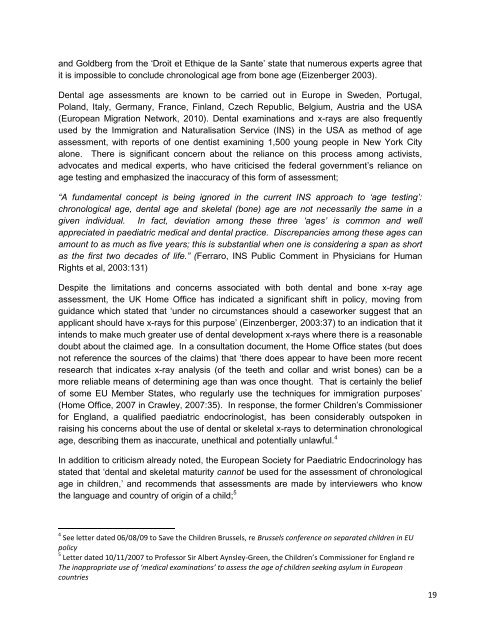Age assessment practices: a literature review & annotated ... - Unicef
Age assessment practices: a literature review & annotated ... - Unicef
Age assessment practices: a literature review & annotated ... - Unicef
Create successful ePaper yourself
Turn your PDF publications into a flip-book with our unique Google optimized e-Paper software.
and Goldberg from the „Droit et Ethique de la Sante‟ state that numerous experts agree that<br />
it is impossible to conclude chronological age from bone age (Eizenberger 2003).<br />
Dental age <strong>assessment</strong>s are known to be carried out in Europe in Sweden, Portugal,<br />
Poland, Italy, Germany, France, Finland, Czech Republic, Belgium, Austria and the USA<br />
(European Migration Network, 2010). Dental examinations and x-rays are also frequently<br />
used by the Immigration and Naturalisation Service (INS) in the USA as method of age<br />
<strong>assessment</strong>, with reports of one dentist examining 1,500 young people in New York City<br />
alone. There is significant concern about the reliance on this process among activists,<br />
advocates and medical experts, who have criticised the federal government‟s reliance on<br />
age testing and emphasized the inaccuracy of this form of <strong>assessment</strong>;<br />
“A fundamental concept is being ignored in the current INS approach to „age testing‟:<br />
chronological age, dental age and skeletal (bone) age are not necessarily the same in a<br />
given individual. In fact, deviation among these three „ages‟ is common and well<br />
appreciated in paediatric medical and dental practice. Discrepancies among these ages can<br />
amount to as much as five years; this is substantial when one is considering a span as short<br />
as the first two decades of life.” (Ferraro, INS Public Comment in Physicians for Human<br />
Rights et al, 2003:131)<br />
Despite the limitations and concerns associated with both dental and bone x-ray age<br />
<strong>assessment</strong>, the UK Home Office has indicated a significant shift in policy, moving from<br />
guidance which stated that „under no circumstances should a caseworker suggest that an<br />
applicant should have x-rays for this purpose‟ (Einzenberger, 2003:37) to an indication that it<br />
intends to make much greater use of dental development x-rays where there is a reasonable<br />
doubt about the claimed age. In a consultation document, the Home Office states (but does<br />
not reference the sources of the claims) that „there does appear to have been more recent<br />
research that indicates x-ray analysis (of the teeth and collar and wrist bones) can be a<br />
more reliable means of determining age than was once thought. That is certainly the belief<br />
of some EU Member States, who regularly use the techniques for immigration purposes‟<br />
(Home Office, 2007 in Crawley, 2007:35). In response, the former Children‟s Commissioner<br />
for England, a qualified paediatric endocrinologist, has been considerably outspoken in<br />
raising his concerns about the use of dental or skeletal x-rays to determination chronological<br />
age, describing them as inaccurate, unethical and potentially unlawful. 4<br />
In addition to criticism already noted, the European Society for Paediatric Endocrinology has<br />
stated that „dental and skeletal maturity cannot be used for the <strong>assessment</strong> of chronological<br />
age in children,‟ and recommends that <strong>assessment</strong>s are made by interviewers who know<br />
the language and country of origin of a child; 5<br />
4 See letter dated 06/08/09 to Save the Children Brussels, re Brussels conference on separated children in EU<br />
policy<br />
5 Letter dated 10/11/2007 to Professor Sir Albert Aynsley-Green, the Children’s Commissioner for England re<br />
The inappropriate use of ‘medical examinations’ to assess the age of children seeking asylum in European<br />
countries<br />
19
















